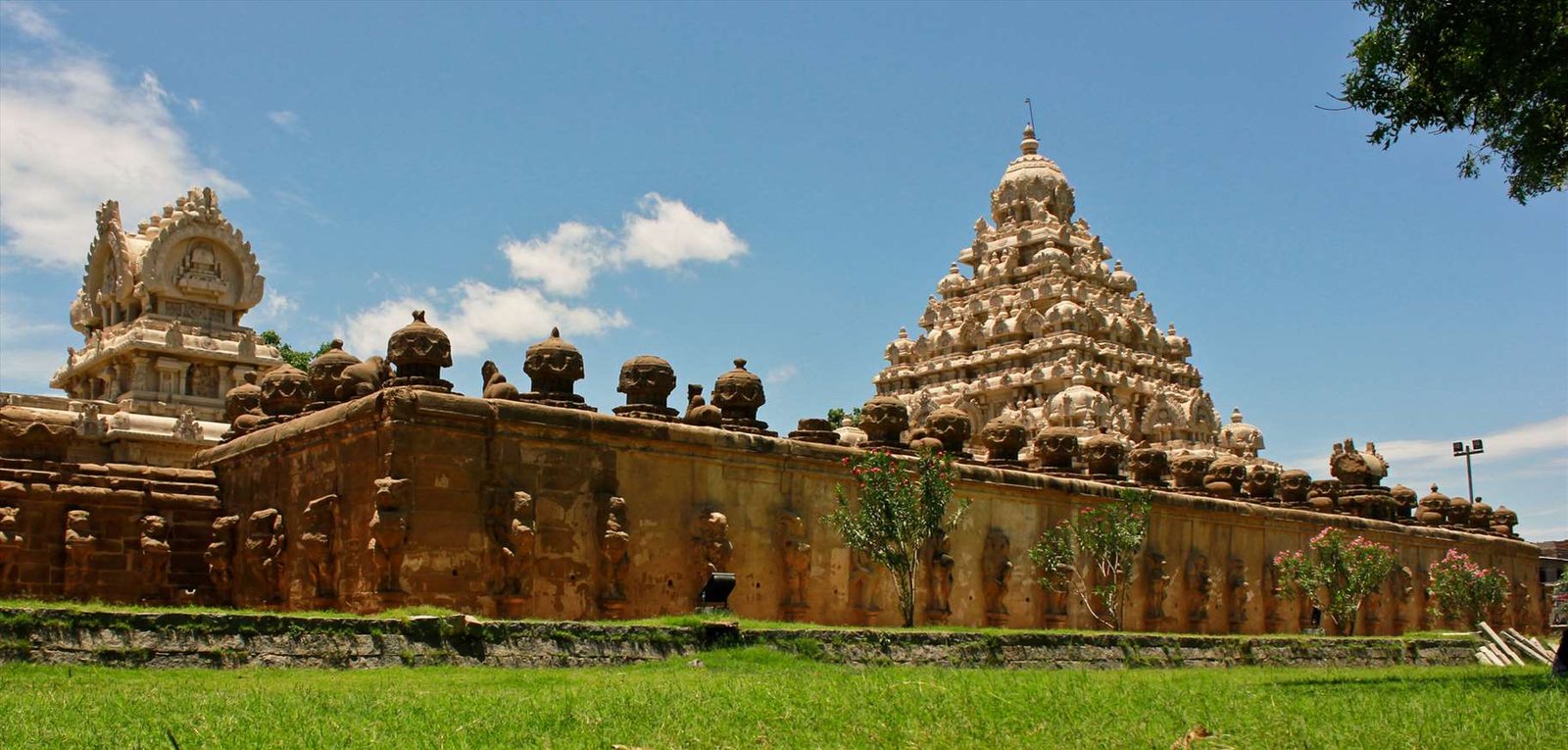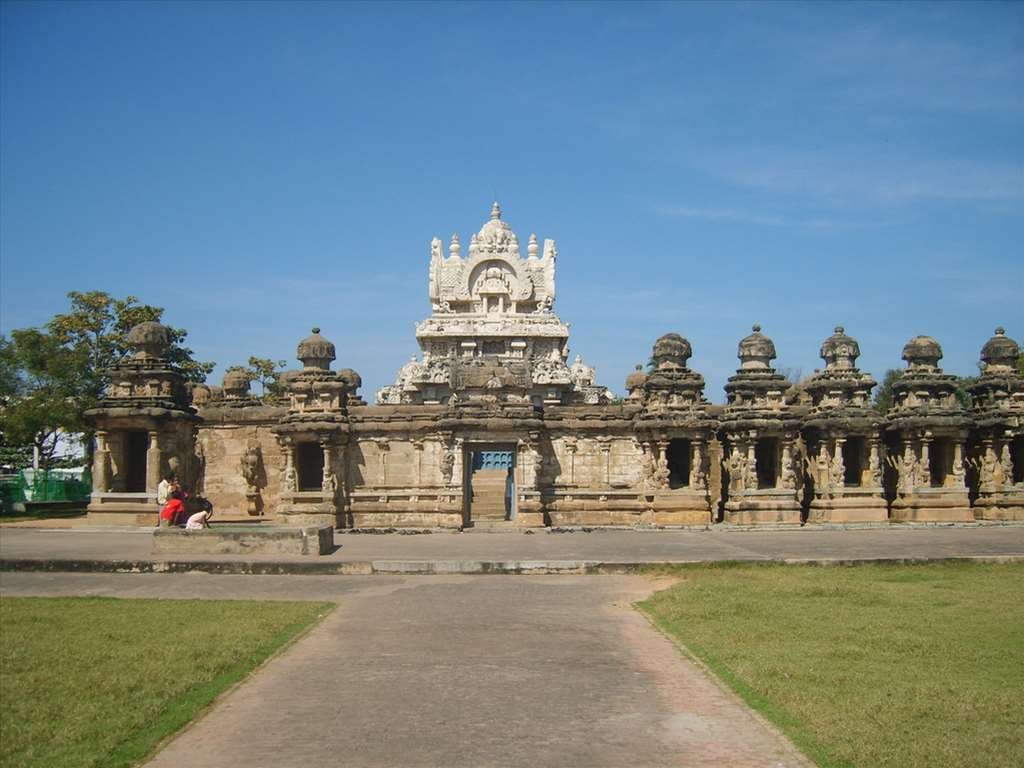Kanchi Kailasanathar temple located in Kanchipuram is a famous temple of Lord Shiva. The Shiva Lingam in this temple is 10 feet high.
Shrine’s History
The Kailasanathar Temple, is built in the tradition of Smartha worship of Shiva, Vishnu, Devi, Surya (Sun), Ganesha and Kartikeya, in Hinduism, a practice which replaced the Buddhism. Temple construction is credited to the Pallava dynasty, who had established their kingdom with Kanchipuram as the capital city, considered one of the seven sacred cities under Hinduism.
There was an interregnum when the Chalukya rulers defeated the Pallavas and occupied Kanchipuram. However, the Pallavas regained their territory and started expanding their capital city of Kanchipuram and built many temples of great magnificence. The only temple of this period which is extant is the Kailsahanathar Temple. The temple was built during 685-705AD. It is the first structural temple built in South India by Narasimhavarman II , and who is also known as Rajasimha Pallaveswaram.
His son, Mahendravarman III, completed the front façade and the gopuram (tower). Prior temples were either built of wood or hewn into rock faces in caves or on boulders, as seen in Mahabalipuram. The Kailasanathar temple became the trend setter for other similar temples in South India. According to local belief, the temple was a safe sanctuary for the rulers of the kingdom during wars. A secret tunnel, built by the kings, was used as an escape route and is still visible. Currently, Kanchi Kailasanathar Temple is maintained by Archaeological Survey of India

Architectural Relevance of This Shrine
The temple has retained the Pallava architecture in its original stylized form with influence of the later styles developed by the Chola Dynasty and Vijayanagara Emperors. It is of stone built architecture unlike the rock cut architecture built into hallowed caves or carved into rock outcrops as in Mahabalipuram. The tall gopuram (tower) is to the left and the temple complex is to the right. The temple’s foundations are made of granite, which could withstand the weight of the temple, while the superstructure, including the carvings, are all made of sandstone.
Initially, only the main sanctuary existed with pyramidal vimana and a detached mandapa. The temple complex is complete in all respects as it has garbagriha (sanctum sanctorum), antarala (inner enclosure), mandapa, a high compound wall, and an entrance gate, the gopuram. The mandapa, which was initially detached, was made part of the main shrine by interposing an ardhamantapa (smaller hall). The pillars of the mandapa have the repetitive features of mythical lion mounts. The structure has a simple layout with a tower or shikara at the center of the complex. The shikara of the temple, above the main shrine (sanctum sanctorum), is square in plan and rises up in a curvilinear style or pyramidal shape.
The tower has many levels rising proportionately.At the top of this tower, there is a small roof in the shape of a dome. The pillar elements with mythical animal shapes (lions on the base) are extra features in Pallava style. At the entrance, the gopuram walls are plastered. Its entrance wall has eight small shrines and a gopura, precursor to the main gopura. At some later stage, the mandapa and the sanctuary were joined by an intermediate hall called the ardhamantapa, which is reported to have marred the beauty of the temple to some extent. The temple is enclosed within walls in a rectangular layout.
The main shrine has a 16 sided Shivalinga in black granite stone deified in the sanctum sanctorum. Within the walls of the main shrine there is padabhanda adhisthana (main pedestal) with very elegantly carved images of gods with a sculpted Nandi, a little distance away giving guard to the deity. On each face of the outer walls of the main shrine there are many carvings of deities. In the south facing wall the sculpture depicts Shiva as Umamaheshavara (Shiva with his consort Parvati) with Lingodbhava (emergence of Shiva as fiery pillar – linga) surrounded by Brahma and Vishnu and flying amaras on the lower level.
The west facing hall has sculptures of Shiva in the form of Sandhya Tandavamurti and Urdhava Tandvamurti and the ensemble is completed with images of ganas in dancing poses and also with images of Brahma, Vishnu, Nandi and Parvati. The carving of Shiva on the north facing wall is a composition of Tripurantaka flanked by three ganas, goddess Durga with three ganas, and goddesses Bhairavi, Kaushiki and Jyestha. The exterior faces of the vimana (tower) have images of aspects of Shiva – Bhikshatana, Somaskanda and in Samhara-Tandava (destructive dancing) pose. In the inner walls of the prakara (circumabulatory passage) there is galaxy of images of Durga, Kartikeya, Bhavati, Tripurantaka, Garudarudha-Vishnu, Asura Samhara (slaying of demons), Narasimha (Vishnu’s avatar), Trivikrama (another Vishnu’s avatar), Shiva Tandava (Shiva in a dancing pose), Shiva severing the fifth head of Brahma, desecration of Yagna of Daksha, Brahma and his wife, Gangadhara, Urdhava tandava, Vishnu flanked by Bhudevi and Sridevi, Lingodbhava, Bhikshatana, Ravana, and Vali offering prayers to Atmalinga Chandikeshvara. Vimana’s south facing wall has very elegant image of Shiva in a sitting posture of peace and quietude known as Dakshinamurthy, and its west wall has Shiva in the form of Lingodbhava.
The tower has multiple shrines embodied on all its external faces which have the appearance of miniature shrines. These shrines have three features, the sala (rectangular), kuta (square) and panjara (apsidal) styles. Eight small shrines also decorate the entrance wall. The 58 small shrines are built into the niches of the compound wall that encloses the main shrine;[citation needed] they depict Somaskanada reliefs of Shiva and his consort Parvathi in many dance forms.

Shrine’s Map Location and How to Go There
By Road
Kailasanathar Temple situated west side of Kanchipuram and is 3 Km from Kanchi bus stand; and 2.7 km from railway station. Somehow there is no local bus service in Kanchipuram. But there are many auto-rickshaws that drive you to the temple. Temple located 1.5 km away from Kanchipuram. Kanchipuram is 75 km from Chennai.
By Rail
The nearest Railway Station is Kanchipuram. From Kanchipuram, the temple is 2.7 km away. Private taxis are available to reach this temple.
By Air
Chennai is the nearest airport. From Chennai, the temple is 75 km away.

Shrine Timings
6 am ? 12 pm, 4 pm- 7 pm
Events Celebrated at This Shrine
Maha Shivaratri is the biggest festival held in the temple when thousand of devotees throng the temple in the evening hours to offer prayers to the main deity
Extra Information About this Shrine
Entry: Free
Photography: Allowed except inside the main Sanctum














































